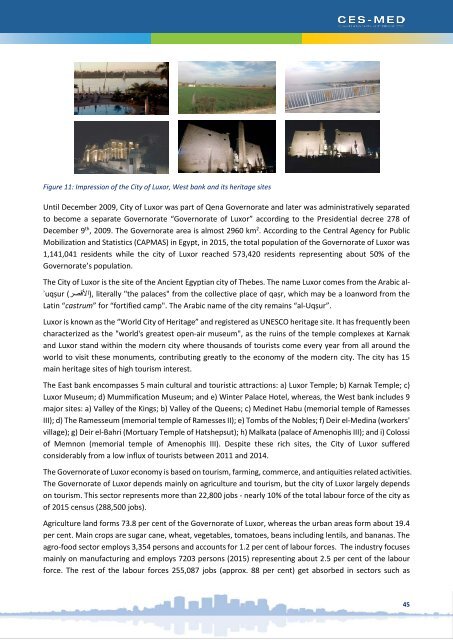130218_Luxor-Egypt SECAP Final
You also want an ePaper? Increase the reach of your titles
YUMPU automatically turns print PDFs into web optimized ePapers that Google loves.
Figure 11: Impression of the City of <strong>Luxor</strong>, West bank and its heritage sites<br />
Until December 2009, City of <strong>Luxor</strong> was part of Qena Governorate and later was administratively separated<br />
to become a separate Governorate “Governorate of <strong>Luxor</strong>” according to the Presidential decree 278 of<br />
December 9 th , 2009. The Governorate area is almost 2960 km 2 . According to the Central Agency for Public<br />
Mobilization and Statistics (CAPMAS) in <strong>Egypt</strong>, in 2015, the total population of the Governorate of <strong>Luxor</strong> was<br />
1,141,041 residents while the city of <strong>Luxor</strong> reached 573,420 residents representing about 50% of the<br />
Governorate’s population.<br />
The City of <strong>Luxor</strong> is the site of the Ancient <strong>Egypt</strong>ian city of Thebes. The name <strong>Luxor</strong> comes from the Arabic al-<br />
ʾuqṣur ,(الأقصر) literally "the palaces" from the collective place of qaṣr, which may be a loanword from the<br />
Latin “castrum” for “fortified camp". The Arabic name of the city remains “al-Uqṣur”.<br />
<strong>Luxor</strong> is known as the “World City of Heritage” and registered as UNESCO heritage site. It has frequently been<br />
characterized as the "world's greatest open-air museum", as the ruins of the temple complexes at Karnak<br />
and <strong>Luxor</strong> stand within the modern city where thousands of tourists come every year from all around the<br />
world to visit these monuments, contributing greatly to the economy of the modern city. The city has 15<br />
main heritage sites of high tourism interest.<br />
The East bank encompasses 5 main cultural and touristic attractions: a) <strong>Luxor</strong> Temple; b) Karnak Temple; c)<br />
<strong>Luxor</strong> Museum; d) Mummification Museum; and e) Winter Palace Hotel, whereas, the West bank includes 9<br />
major sites: a) Valley of the Kings; b) Valley of the Queens; c) Medinet Habu (memorial temple of Ramesses<br />
III); d) The Ramesseum (memorial temple of Ramesses II); e) Tombs of the Nobles; f) Deir el-Medina (workers'<br />
village); g) Deir el-Bahri (Mortuary Temple of Hatshepsut); h) Malkata (palace of Amenophis III); and i) Colossi<br />
of Memnon (memorial temple of Amenophis III). Despite these rich sites, the City of <strong>Luxor</strong> suffered<br />
considerably from a low influx of tourists between 2011 and 2014.<br />
The Governorate of <strong>Luxor</strong> economy is based on tourism, farming, commerce, and antiquities related activities.<br />
The Governorate of <strong>Luxor</strong> depends mainly on agriculture and tourism, but the city of <strong>Luxor</strong> largely depends<br />
on tourism. This sector represents more than 22,800 jobs - nearly 10% of the total labour force of the city as<br />
of 2015 census (288,500 jobs).<br />
Agriculture land forms 73.8 per cent of the Governorate of <strong>Luxor</strong>, whereas the urban areas form about 19.4<br />
per cent. Main crops are sugar cane, wheat, vegetables, tomatoes, beans including lentils, and bananas. The<br />
agro-food sector employs 3,354 persons and accounts for 1.2 per cent of labour forces. The industry focuses<br />
mainly on manufacturing and employs 7203 persons (2015) representing about 2.5 per cent of the labour<br />
force. The rest of the labour forces 255,087 jobs (approx. 88 per cent) get absorbed in sectors such as<br />
45

















